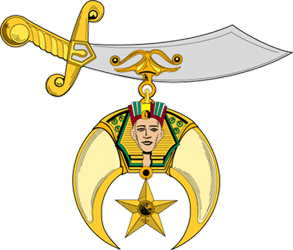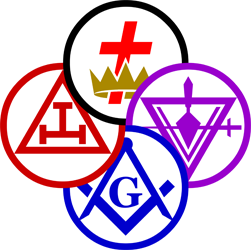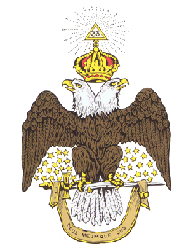Appendant Organizations
Shriners International
 In 1870 a group of Masons gathered frequently for lunch at the Knickerbocker Cottage on Sixth Avenue in New York City. At a special table on the second floor a particularly fun-loving group of men met regularly. Among the regulars were Walter M. Fleming, M.D. and William J. “Billy” Florence, an actor. The group frequently talked about starting a new fraternity for Masons – one centered on fun and fellowship, more than ritual. Fleming and Florence took this idea seriously enough to do something about it.
In 1870 a group of Masons gathered frequently for lunch at the Knickerbocker Cottage on Sixth Avenue in New York City. At a special table on the second floor a particularly fun-loving group of men met regularly. Among the regulars were Walter M. Fleming, M.D. and William J. “Billy” Florence, an actor. The group frequently talked about starting a new fraternity for Masons – one centered on fun and fellowship, more than ritual. Fleming and Florence took this idea seriously enough to do something about it.
Billy Florence had been on tour in France, and had been invited to a party given by an Arabian diplomat. The exotic style, flavors and music of the Arabian-themed party inspired him to suggest this as a theme for the new fraternity. Walter Fleming, a devoted fraternity brother, built on Fleming’s ideas and used his knowledge of fraternal ritual to transform the Arabian theme into the Ancient Arabic Order of the Nobles of the Mystic Shrine (A.A.O.N.M.S.).
The first meeting of Mecca Shriners, the first temple (chapter) established in the United States, was held September 26, 1872.
The Grand York Rite of Georgia
 The York Rite is one of the appendant bodies of Freemasonry that a Master Mason may join to further his knowledge of Freemasonry. But the York Rite is not found as a single system worldwide, and outside of the York Rite there are often significant differences in ritual, as well as organization. However, in most cases, provided that the Grand Body in question regards the parent "Craft" jurisdiction as regular, each distinct Order has recognised fraternal inter-relations with the respective Grand Body within the York system.
The York Rite is one of the appendant bodies of Freemasonry that a Master Mason may join to further his knowledge of Freemasonry. But the York Rite is not found as a single system worldwide, and outside of the York Rite there are often significant differences in ritual, as well as organization. However, in most cases, provided that the Grand Body in question regards the parent "Craft" jurisdiction as regular, each distinct Order has recognised fraternal inter-relations with the respective Grand Body within the York system.
The York Rite or American Rite is one of several Rites of Freemasonry. A Rite is a series of progressive degrees that are conferred by various Masonic organizations or bodies, each of which operates under the control of its own central authority. The York Rite specifically is a collection of separate Masonic Bodies and associated Degrees that would otherwise operate independently. The three primary bodies in the York Rite are the Chapter of Royal Arch Masons, Council of Royal & Select Masters or Council of Cryptic Masons, and the Commandery of Knights Templar, each of which are governed independently but are all considered to be a part of the York Rite. There are also other organizations that are considered to be directly associated with the York Rite, or require York Rite membership to join such as the York Rite Sovereign College but in general the York Rite is considered to be made up of the aforementioned three. The Rite's name is derived from the city of York, where, according to a Masonic legend, the first meetings of Masons in England took place, although only the lectures of the York Rite Sovereign College make reference to that legend.
The Scottish Rite of Freemasonry
 The Scottish Rite is one of the appendant bodies of Freemasonry that a Master Mason may join for further exposure to the principles of Freemasonry. In England and some other countries, while the Scottish Rite is not accorded official recognition by the Grand Lodge, there is no prohibition against a Freemason electing to join it. In the United States, however, the Scottish Rite is officially recognized by Grand Lodges as an extension of the degrees of Freemasonry. The Scottish Rite builds upon the ethical teachings and philosophy offered in the craft lodge, or Blue Lodge, through dramatic presentation of the individual degrees.
The Scottish Rite is one of the appendant bodies of Freemasonry that a Master Mason may join for further exposure to the principles of Freemasonry. In England and some other countries, while the Scottish Rite is not accorded official recognition by the Grand Lodge, there is no prohibition against a Freemason electing to join it. In the United States, however, the Scottish Rite is officially recognized by Grand Lodges as an extension of the degrees of Freemasonry. The Scottish Rite builds upon the ethical teachings and philosophy offered in the craft lodge, or Blue Lodge, through dramatic presentation of the individual degrees.
The thirty-three degrees of the Scottish Rite are conferred by several controlling bodies. The first of these is the Craft Lodge which confers the Entered Apprentice, Fellowcraft, and Master Mason degrees. Craft lodges operate under the authority of Grand Lodges, not the Scottish Rite. Although most lodges throughout the English-speaking world do not confer the Scottish Rite versions of the first three degrees, there are a handful of lodges in New Orleans and in several other major cities that have traditionally conferred the Scottish Rite version of these degrees.



